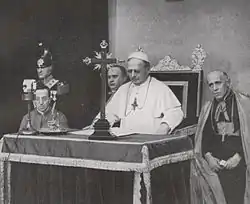
In sixteen years, Pope Pius XI (r. 1922–1939) created 76 cardinals in 17 consistories. Though he created 18 cardinals at a consistory in 1935, he typically created very few cardinals at one time, holding small, frequent consistories, some of them less than six months apart. He held a consistory in 1929 to create just one cardinal, and created just two on eight occasions.
Of his appointments to the College of Cardinals, 43 were Italians.[1] He appeared to strive to maintain an equilibrium between Italians and non-Italians and two of his consistories produced an equal division between the two groups, in March 1924 and December 1927. Non-Italians formed a majority of the college for several months in 1925 and again from 1928 to 1933. This balance reflected concerns about the independence of the Holy See and Italy during Benedict's papacy, and their new relationship established with the Lateran Treaty in 1929.
At its largest during his papacy, in December 1935, the college had 68 members, two short of the maximum size of 70 set by Pope Sixtus V in 1586.[2] In 1927, he accepted a cardinal's resignation, the only one to occur in the 20th century. The cardinals he created included one future pope, Pope Pius XII.
11 December 1922
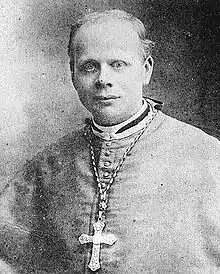
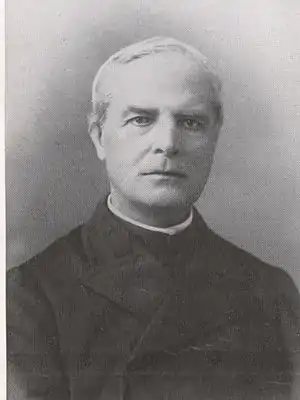
Pius created eight cardinals at his first consistory, which six of them attended. Reig, Archbishop of Toledo, received his red hat from the King of Spain, and Locatelli, Papal Nuncio to Portugal, from the President of the Portuguese Republic.[3][lower-alpha 1] In the case of Reig y Casanova, a widower, Pius ignored the rule established in 1585 by Pope Sixtus V that no one who had been married could be made a cardinal.[5] Father Ehrle, a Jesuit who had served as Vatican Archivist for several years, initially declined the honor, but relented after a private meeting with Pius.[6][7]
| Name | Country |
|---|---|
| Achille Locatelli (1856–1935) | |
| Giovanni Bonzano (1867–1927) | |
| Enrique Reig y Casanova (1858–1927) | |
| Alexis-Armand Charost (1860–1930) | |
| Eugenio Tosi (1864–1929) | |
| Stanislas Touchet (1842–1926) | |
| Giuseppe Mori (1850–1934) | |
| Franz Ehrle (1845–1934) |
23 May 1923
Pius added two Italian cardinals on 23 May 1923.[4]
| Name | Country |
|---|---|
| Giovanni Nasalli Rocca di Corneliano (1872–1952) | |
| Luigi Sincero (1870–1936) |
20 December 1923
Pius created two Italian cardinals on 20 December 1923,[8] both longtime officials in the Roman Curia.
| Name | Country |
|---|---|
| Evaristo Lucidi (1866–1929) | |
| Aurelio Galli (1866–1929) |
24 March 1924
Pius named a pair of American archbishops cardinals on 24 March 1924.[9] This brought the membership of the College of Cardinals to a total of 66, 33 Italians and 33 non-Italians: seven French, seven German, four American, four Spanish, two English, two Polish, and one each of Belgian, Hungarian, Irish, Portuguese, Brazilian, Dutch, and Canadian.[10]
| Name | Country |
|---|---|
| George Mundelein (1872–1939) | |
| Patrick Joseph Hayes (1867–1938) |
30 March 1925
Pius named a pair of Spanish archbishops cardinals on 30 March 1925.[11] Both received their red birettas in Madrid from King Alfonso in a ceremony that included an address by the King in Latin.[12]
The previous consistory had left the college with 33 Italians and 33 non-Italians. The deaths of the Irish Michael Logue on 19 November and the Italian Oreste Giorgi on 24 December maintained that balance. This consistory gave the non-Italians a majority of 34 to 32.
| Name | Country |
|---|---|
| Eustaquio Ilundain y Esteban (1862–1937) | |
| Vicente Casanova y Marzol (1854–1930) |
14 December 1925
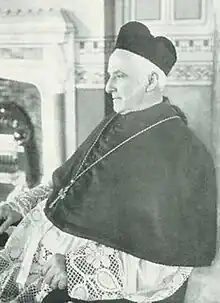
Pius named four cardinals on 14 December 1925, three Italians (two diplomats and a curia official), and an Irish archbishop.[13] He made an exception to the 1917 Code of Canon Law that prohibited cardinals from being closely related to one another. The new cardinal Enrico Gasparri was the nephew of Cardinal Secretary of State Pietro Gasparri.[14]
The previous consistory had left the non-Italians with a 34 to 32 majority that had fallen by one with the death of Canadian Louis-Nazaire Bégin on 18 July 1925. This consistory restored the Italian majority once again.
| Name | Country |
|---|---|
| Bonaventura Cerretti (1872–1933) | |
| Enrico Gasparri (1871–1946) | |
| Patrick O'Donnell (1856–1927) | |
| Alessandro Verde (1865–1958) |
21 June 1926
Pius named two new cardinals on 21 June 1926, both Italian curia officials.[15]
| Name | Country |
|---|---|
| Luigi Capotosti (1863–1938) | |
| Carlo Perosi (1868–1930) |
20 December 1926
On 6 December 1926, Pius announced he would create two cardinals at a consistory on 20 December. Both were Italians, one the Bishop of Turin and the other a papal nuncio.[16]
| Name | Country |
|---|---|
| Lorenzo Lauri (1864–1941) | |
| Giuseppe Gamba (1857–1929) |
20 June 1927
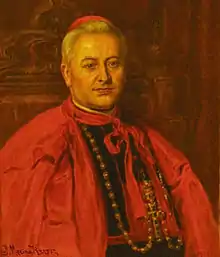
On 2 May 1927, Pius announced he would create two cardinals at a consistory on 20 June. Both were Archbishops, one Belgian and one Polish.[17]
| Name | Country |
|---|---|
| Jozef-Ernest van Roey (1874–1961) | |
| August Hlond (1881–1948) |
19 December 1927

At this consistory Pius announced that he had accepted the resignation of French Jesuit theologian Louis Billot from the College of Cardinals,[18][19] as reported in September.[20] It was the only resignation from the college in the 20th century.[21] Pius X had named him a cardinal in 1911.
With the creation of five non-Italian cardinals at this consistory, the college again reached a numerical balance with 33 Italians and 33 non-Italians.[22][lower-alpha 2]

| Name | Country |
|---|---|
| Alexis Lépicier (1863–1936) | |
| Felix-Raymond-Marie Rouleau (1866–1931) | |
| Pedro Segura y Sáenz (1880–1957) | |
| Charles Binet (1869–1936) | |
| Jusztinián György Serédi (1884–1945) |
15 July 1929
The deaths of several Italians altered the balance in the college by 31 March 1929 to 26 Italians and 33 non-Italians. It was rumored that Pius would appoint more non-Italians once the Holy See reached an agreement with the government of Italy about the legal status of the Vatican City State.[23] Pius named Alfredo Schuster, an Italian of German-Swiss heritage, Archbishop of Milan and made him a cardinal on 15 July 1929.[24]
| Name | Country |
|---|---|
| Alfredo Ildefonso Schuster (1880–1954) |
16 December 1929
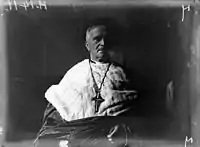
In advance of this consistory, New York Times correspondent Arnaldo Coresi speculated whether Pius would restore an Italian majority in the College of Cardinals in deference to Italian sensibilities following the ratification of the Lateran Treaty between Italy and the Holy See earlier in the year which the election of a non-Italian pope might disturb. The contrary argument was that creating a non-Italian majority in the college would demonstrate papal independence and allay fears that the Treaty gave Italy undue influence in Church affairs.[25] Pius divided his appointments evenly: three from Italy, and one each from France, Ireland, and Portugal. The consistory left the Italians in the minority, with 30 out of 63 members.[26]
| Name | Country |
|---|---|
| Manuel Gonçalves Cerejeira (1888–1977) | |
| Eugenio Pacelli (1876–1958) | |
| Luigi Lavitrano (1874–1950) | |
| Carlo Minoretti (1861–1938) | |
| Joseph MacRory (1861–1945) | |
| Jean Verdier (1864–1940) |
30 June 1930
At this consistory Pius made three Italian officials of the Roman Curia, a Brazilian archbishop, and a French bishop cardinals. It left the college balanced between 31 Italians and 32 non-Italians.[27]
| Name | Country |
|---|---|
| Sebastião da Silveira Cintra (1882–1942) | |
| Francesco Marchetti Selvaggiani (1871–1951) | |
| Raffaele Rossi (1876–1948) | |
| Giulio Serafini (1867–1938) | |
| Achille Liénart (1884–1973) |
13 March 1933
After creating cardinals at thirteen consistories in less than eight years, Pius waited longer than ever before to hold his next consistory in March 1933, more than two years and eight months.[28] He nevertheless brought the membership of the college from 52 to just 58 by naming six cardinals: four Italians, an Austrian, and a Canadian.[29] This gave the Italians a majority in College for the first time in several years. Pius announced he was making two additional prelates cardinals but withheld their names, which the press speculated meant they were too important in their present posts to be transferred from positions not normally held by a cardinal.[30]
| Name | Country |
|---|---|
| Angelo Dolci (1867–1939) | |
| Pietro Fumasoni Biondi (1872–1960) | |
| Maurilio Fossati (1876–1965) | |
| Jean-Marie-Rodrigue Villeneuve (1883–1947) | |
| Elia Dalla Costa (1872–1961) | |
| Theodor Innitzer (1875–1955) |
Cardinals in pectore
| Name | Country | Revealed as Cardinal |
|---|---|---|
| Federico Tedeschini (1873–1959) | 16 December 1935[31][32] | |
| Carlo Salotti (1870–1947) | 16 December 1935[31] |
16 December 1935
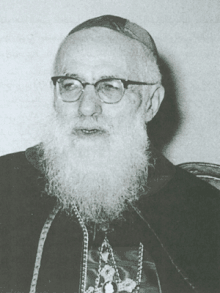
On 21 November 1935, Pope Pius named 18 prelates he planned to make cardinals at a consistory on 16 December. Thirteen were Italians and five came from other countries. One of them was the first Eastern Rite patriarch to enter the college since 1895. It was the first consistory to create as many as 18 cardinals since Pius X did so in 1911.[lower-alpha 3] Pius also revealed the names of two he added secretly in 1933.[34] Four of the new cardinals, papal nuncios unable to attend the ceremony, participated in the next reception of new cardinals in June 1936.[35][lower-alpha 4] As was traditional for the Apostolic Nuncio to Spain, Tedeschini, created in pectore at the previous consistory, received his red biretta from Spanish President Alcalá Zaomora, head of "one of the most officially anti-clerical nations in the world".[32] With this consistory the college grew to 68 members, 37 of them Italians.[31][lower-alpha 5]
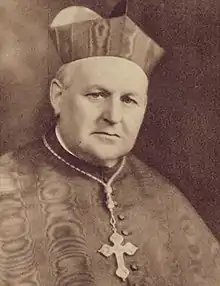
| Name | Country |
|---|---|
| Ignatius Gabriel I Tappouni (1879–1968) | |
| Enrico Sibilia (1861–1948) | |
| Francesco Marmaggi (1870–1949) | |
| Luigi Maglione (1877–1944) | |
| Carlo Cremonesi (1866–1943) | |
| Alfred-Henri-Marie Baudrillart (1859–1942) | |
| Emmanuel Célestin Suhard (1874–1949) | |
| Karel Kašpar (1870–1941) | |
| Santiago Copello (1880–1967) | |
| Isidro Goma y Tomas (1869–1940) | |
| Camillo Caccia Dominioni (1877–1946) | |
| Nicola Canali (1874–1961) | |
| Domenico Jorio (1867–1954) | |
| Vincenzo Lapuma (1874–1943) | |
| Federico Cattani Amadori (1856–1943) | |
| Massimo Massimi (1877–1954) | |
| Domenico Mariani (1863–1939) | |
| Pietro Boetto (1871–1946) |
15 June 1936
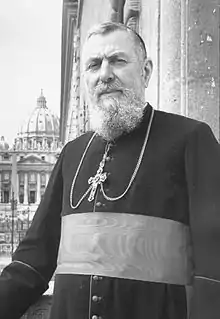
Both new cardinals had spent years in various positions at the Vatican Library,[35] where Pius himself had worked early in his career.
| Name | Country |
|---|---|
| Giovanni Mercati (1866–1957) | |
| Eugène Tisserant (1884–1972) |
13 December 1937
Pius' health had been so poor that on 21 December 1936 the U.S. weekly magazine Life published picture of the 66 cardinals then living with the advice: "Disregard non-Italians and old men: somewhere among the others is the face of the next Pope."[36][37] A year later, Pius reminded those assembled at a consistory held in December 1937 that it might be his last.[38] With the appointment of 3 Italians and 2 non-Italians at his last consistory, Pius increased the Italians to 39 out of 60 members of the College of Cardinals.[39][40]
| Name | Country |
|---|---|
| Adeodato Giovanni Piazza (1884–1957) | |
| Ermenegildo Pellegrinetti (1876–1943) | |
| Arthur Hinsley (1865–1943) | |
| Giuseppe Pizzardo (1877–1970) | |
| Pierre-Marie Gerlier (1880–1965) |
Notes
- ↑ Reig y Casanova and Locatelli participated in the Vatican ceremony in 1923.[4]
- ↑ The next several cardinals to die were all Italians, putting them in the minority once more as early as 30 June 1928 with the death of Cardinal Giovanni Tacci Porcelli, followed by the deaths of Cardinals Gaetano de Lai on 24 October 1928, Giuseppe Francica-Nava de Bontifè on 7 December 1928, Eugenio Tosi on 7 January 1929, Aurelio Galli on 26 March 1929, and Evaristo Lucidi on 31 March 1929.
- ↑ In 1911, Pius X created 19 cardinals, but reserved the name of one in pectore and announced the names of 18.[33]
- ↑ The four and their assignments were Sibilia (Vienna), Marmaggi (Warsaw), Maglioni (Paris), and Tedeschini (Madrid).
- ↑ But for the death of Cardinal Michele Lega a few hours before the consistory, the College would have reached 69 members.
References
- ↑ Putnam, William Lowell (2006). "Appendex B". The Mountaineer's Pontiff: Achille Ratti. Light Technology Publishing. ISBN 9781622336906. According to Putnam, Pius named 75 cardinals, not 76, possibly counting Billot's resignation as a subtraction.
- ↑ Noonan, James-Charles (2012). The Church Visible: The Ceremonial Life and Protocol of the Roman Catholic Church, Revised Edition. New York: Sterling Ethos. pp. 8–9. ISBN 978-1-40278730-0.
- ↑ "8 New Cardinals Today" (PDF). New York Times. 11 December 1922. Retrieved 16 July 2018.
- 1 2 "Pope Gives Two Red Hats" (PDF). New York Times. Associated Press. 26 May 1923. Retrieved 16 July 2018.
- ↑ "Cardinal Reig Dies in Spain at Age of 77" (PDF). New York Times. 26 August 1927. Retrieved 16 July 2018.
- ↑ "Declines the Cardinalate" (PDF). New York Times. 21 November 1922. Retrieved 16 July 2018.
- ↑ "Cardinal Ehrle Dies at 88 in Rome" (PDF). New York Times. 1 April 1934. Retrieved 16 July 2018.
- ↑ "Pope Sees No Gain for Europe's Peace" (PDF). New York Times. 21 December 1923. Retrieved 12 November 2017.
- ↑ "Pope Pius Bestows Rank of Cardinal on Archbishops Hayes and Mundelein; Pays Glowing Tribute to our Charity" (PDF). New York Times. 25 March 1924. Retrieved 11 November 2017.
- ↑ "Foreigners Strong in Sacred College" (PDF). New York Times. 13 March 1924. Retrieved 11 November 2017.
- ↑ "Two Cardinals Named" (PDF). New York Times. 31 March 1925. Retrieved 11 November 2017.
- ↑ "Alfonso Gives Red Hats" (PDF). New York Times. Associated Press. 17 April 1925. Retrieved 11 November 2017.
- ↑ "Four Cardinals Elevated by Pope" (PDF). New York Times. 15 December 1925. Retrieved 11 November 2017.
- ↑ "The Cardinals of the Holy Roman Church Biographical Dictionary Pope Pius X (1903-1914) Consistory of December 16, 1907 (IV)". cardinals.fiu.edu. Retrieved 14 August 2021.
- ↑ "Two Cardinals Named" (PDF). New York Times. 22 June 1926. Retrieved 11 November 2017.
- ↑ "Pope Will Create Two New Cardinals" (PDF). New York Times. 7 December 1926. Retrieved 11 November 2017.
- ↑ "To Create New Cardinals" (PDF). New York Times. 3 May 1927. Retrieved 11 November 2017.
- ↑ "Pope in Allocution Silent on Disputes" (PDF). New York Times. 20 December 1927. Retrieved 27 March 2017.
- ↑ "Billot Dead at 85; A Retired Cardinal" (PDF). New York Times. 19 December 1931. Retrieved 27 March 2017.
- ↑ "Say Cardinal Resigned over French Paper Ban" (PDF). New York Times. 21 September 1927. Retrieved 13 July 2018.
- ↑ Walsh, Michael J. (2010). The Cardinals: Thirteen Centuries of the Men Behind the Papal Throne. William B. Eerdmanns Publishing. p. 220. ISBN 9780802829412. Retrieved 17 September 2017.
- ↑ "Cardinal A. Galli Dies from Stroke" (PDF). New York Times. 27 March 1929. Retrieved 11 November 2017.
- ↑ "Cardinal E.Lucidi Dies in Rome at 63" (PDF). New York Times. 1 April 1929. Retrieved 12 November 2017.
- ↑ "Schuster Named Cardinal by Pope" (PDF). New York Times. 16 July 1929. Retrieved 12 November 2017.
- ↑ Cortesi, Arnaldo (13 October 1929). "See Pope Creating Ten Cardinals Soon" (PDF). New York Times. Retrieved 16 July 2018.
- ↑ "Pope Will Create Six Cardinals Today" (PDF). New York Times. 16 December 1929. Retrieved 16 July 2018.
- ↑ "Five Prelates Named to Become Cardinals" (PDF). New York Times. 6 June 1930. Retrieved 16 July 2018.
- ↑ Cortesi, Arnaldo (15 January 1933). "Consistory Likely Before Holy Year" (PDF). New York Times. Retrieved 17 July 2018.
- ↑ "Pope to Elevate 6 to Cardinalate" (PDF). New York Times. 13 February 1933. Retrieved 16 July 2018.
- ↑ Cortesi, Arnaldo (14 March 1933). "Pope Cites Dangers Facing the World in Consistory Talk" (PDF). New York Times. Retrieved 16 July 2018.
- 1 2 3 Cortesi, Arnaldo (17 December 1935). "20 New Cardinals Created by Pope" (PDF). New York Times. Retrieved 16 July 2018.
- 1 2 José M. Sánchez (April 1963). "The Second Spanish Republic and the Holy See: 1931-1936". Catholic Historical Review. 49 (1): 47–68, esp. 65–6. JSTOR 25017192.
- ↑ Murphy, Joseph J. (October 1914). "Pius X and the Cardinalate". The Ecclesiastical Review. Philadelphia: The Dolphin Press. LI: 440ff. Retrieved 6 March 2021.
- ↑ "Pope Elevates 20 to Cardinals' Rank" (PDF). New York Times. 21 November 1935. Retrieved 27 October 2017.
- 1 2 "Red Hats are Given to Six by the Pope" (PDF). New York Times. 19 June 1936. Retrieved 16 July 2018.
- ↑ "The Princes of the Church". Life. Vol. 1, no. 5. 21 December 1936. p. 22. Retrieved 17 July 2018.
- ↑ "Pope has Relapse; Rest is Essential" (PDF). New York Times. Associated Press. 18 December 1936. Retrieved 17 July 2018.
- ↑ Aradi, Zsolt (2017). Pius XI: The Pope and the Man. Pickle Partners Publishing. p. . ISBN 9781787205000. Retrieved 17 July 2018.
- ↑ Cortesi, Arnaldo (18 November 1937). "Pope Pius to Name Five as Cardinals" (PDF). New York Times. Retrieved 16 July 2018.
- ↑ "Pope Pius Grieves over Eastern War" (PDF). New York Times. 14 December 1937. Retrieved 16 July 2018.
- Additional sources
- Lentz III, Harris M. (2002). Popes and Cardinals of the 20th Century: A Biographical Dictionary. McFarland & Company. ISBN 978-0-7864-4101-3.
External links
- Miranda, Salvador. "Consistories for the creation of Cardinals, 20th Century (1903-2005): Pius XI (1922-1939)". The Cardinals of the Holy Roman Church. Florida International University. OCLC 53276621.